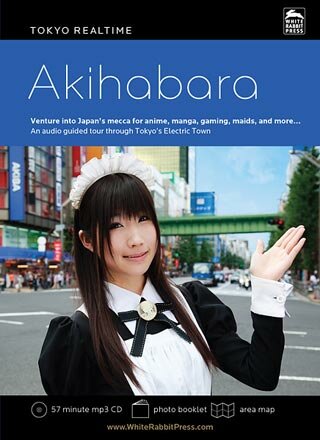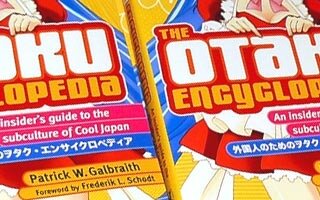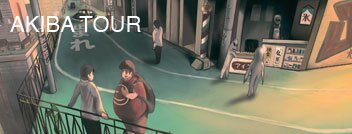30.05.2010 · by Patrick W. Galbraith
The Politics of Popular Culture

Temple University Japan will be holding two conferences on Japanese popular culture as part of the Summer Institute. The first will be on politicizing Japanese popular culture, and includes panels on gaming, otaku and "Cool Japan." I will present on the limitations of "otaku studies." The second will be about gendered labor in Japanese popular culture, and includes discussions of hostess clubs, host clubs and enjo kosai. I will be presenting on maid cafes. Each event is 1,000 yen, including a reception with food and drink after the papers and discussion. Details are available at the official site.
18.12.2009 · by Adrian A. Lozano
Patrick heads to AniFusion NYC

While sifting through a few piles of "Droppings" over at one of our
fellow comrade's online portholes; I was pointed to some free PR for AniFusion NYC. Thanks for the laugh by the way. So if you happen to be in New York the event will be taking place this Sunday December 20th over at Forbidden Planet New York City. As always Patrick is happy to talk about his research and personal opinion about the pros and cons of the Otaku status in and outside of Japan.
“AniFusion NYC: A One-Day Celebration of American/Japanese-Pop Fusion” on Sunday, December 20, 2009 from 2:00 PM ~ 5:00 PM at Forbidden City (212 Avenue A, New York, NY 1009, between 13th and 14th).
Tags: Otaku International Academic 0 Comments
07.12.2009 · by Patrick W. Galbraith
Otaku academic conference in Ottawa

I will be presenting on the potential, and limits, of moe and talking about my . Thomas LaMarre, who recently published a on anime, will also be in attendance. I believe in addition to our presentations we will dialogue about otaku. Looking forward to seeing how the event turns out! BTW, the name of the conference is in fact "Oniichan, what does moe mean?" This was not my idea, and yes, this is a real event. Just in case there are any doubts.
2010年1月にカナダのオタワ大学で「おたく」というテーマで学術発表会が開かれます。私は「萌え」について発表する予定で、トマス・ラマール先生はアニメについて発表するようです。それから、私と先生はおたくの社会的生態について対話します。因に、発表会のタイトルは「お兄ちゃん、萌えって何?」になってしまいました。本当に。これはネタではありません!
01.11.2009 · by Patrick W. Galbraith
Academic article on moe published

My most recent article, "Moe: Exploring Virtual Potential in Post-Millennial Japan" has just been published in the Electronic Journal of Contemporary Japanese Studies, a peer-reviewed, open-access journal. Check it out here! Long be the age of affect!
「萌え」について論文を書かせて頂き、昨日アップされました。申し訳ないですが、英語のみですが、ご興味がありましたらご覧頂ければと思っております。詳しくはこちらへ。
Tags: Moe Academic 0 Comments
15.08.2009 · by Patrick W. Galbraith
Young Anime People - Yappies!
Matt Alt has just posted a fascinating page from the history of otaku, discovered in "The Anime," circa August 1984. Wild stuff! Check it out here.
Tags: Otaku Academic 0 Comments
23.11.2008 · by Patrick W. Galbraith
Akihabara's Future: Morikawa Kaichiro

The New Japan Society for Future Research (新日本未来学会), a venerable organization founded in 1968, came off of hiatus to meet in the Dai-biru on November 23 and discuss Morikawa Kaichiro's theories of futurity and Akihabara.
"I was born in a generation when people didn't go to the moon," Morikawa said. "For me, the future is a thing of the past. ... Those without future put those hopes and dreams into science fiction anime, which then became just anime."
Morikawa (second from the right in this picture) placed the shift from worship of past to belief in future on the French Revolution, but then said that was derailed by wars and environmental and technological chaos after WWII. In accordance with his well known hypothesis from his book "Learning from Akihabara," Morikawa stated Akihabara was transformed into a city of otaku by youth who poured all their energies into hobbies rather than future.
From both architectural and social stances, he criticized the Redevelopment Zone of Akihabara as "a place like any other in the world" in contrast to Chuo-dori and "Japanese subculture, which is always in contrast to the mainstream culture adopted from foreign nations."
He drew an example from Bruno Taut, an architect who visited Japan between 1933 and 1936 and said offhandedly that Katsurarikyuu was "real" Japanese taste and Nikko was gaudy and "false." Before his visit, Nikko, where shogun Tokugawa Ieyasu is enshrined, was by far more beloved than the wabi/sabi of Katsura, but after Taut the government pushed Japan as home of subdued modern design.
Just so is the government picking up on Cool Japan to reassert gaudy pop-culture as the new Japan chic. Morikawa suggested that as Murakami Takashi pushes otaku as "Japan" overseas, it might be possible that in another five years Chuo-dori will be more supported than the Redevelopment Zone, which he sees as a remnant of unnecessary technology pushed on Japan by too much foreign influence.
Morikawa showed a composite image of the Dai-biru and UDX Building both plastered with drooling moe characters, rising sun designs and the words "welcome to Japan."
Patrick W. Galbraith, who was invited as a commentator, questioned whether Japan would ever be willing brand itself with a 50-foot-tall "Ichigo Marshmallow" image.
"When visitors come to Akihabara from overseas, they are expecting that kind of freedom, but what they get is police chasing cosplayers off the streets to make way for shoppers," he said. "It is a fact that JNTO surveys show Japan as a more anticipated tourist spot than Tokyo Disneyland, but it is also true that it now voted the most disappointing place in Japan."
He suggested that Japan doesn't seem to want to be considered a nation of otaku; for all the talk of otaku as a "revolutionary" social movement, they certainly aren't treated as such.
Indeed, Morikawa spoke of his advertisement for the otaku exhibit at the 2004 Venezia Biennale being banned in Ebisu - near the center of Tokyo.
Another commentator just thought all this pressure on Akihabara was unnecessary.
"Maybe Japan would be better off if it returned to its period of national isolation and ignored foreign pressure," said commentator Endo Satoshi, the former editor of doujinshi "Otona no Club" which ran Nakamori Akio's article "Otaku Kenkyuu" as a special to "Manga Burriko."
Morikawa seemed to agree.
"Otaku are escaping from mainstream society [imported foreign culture] and creating [Japanese] subculture," he said. "I think that in otaku lies one possible model for the future."
Tags: Akihabara Otaku Academic 0 Comments
















